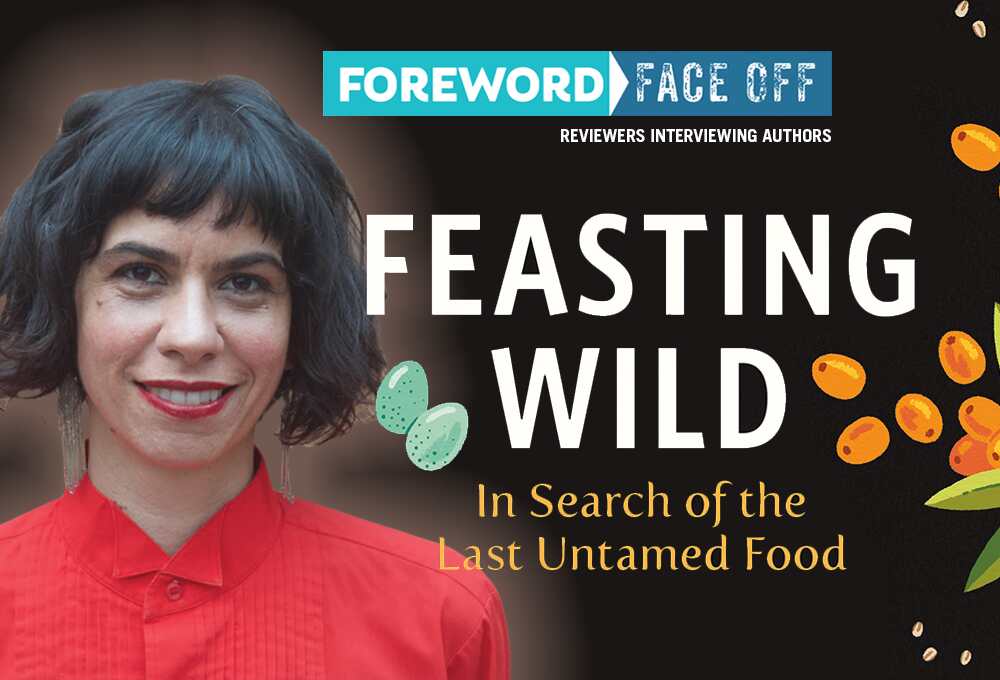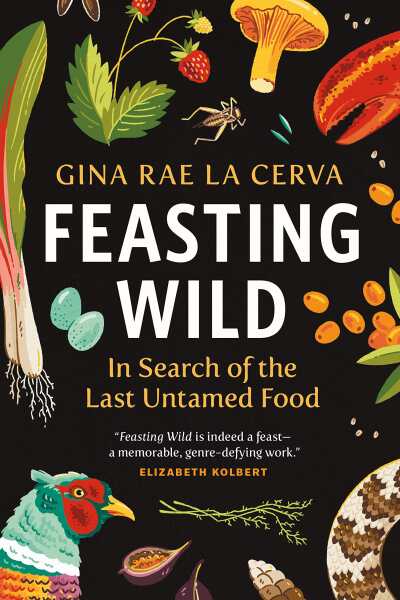Reviewer Michelle Anne Schingler Interviews Gina Rae La Cerva, Author of Feasting Wild: In Search of the Last Untamed Food

It’s easy to forget that much of human evolution came down to a game of I Dare You To Eat That. Think about hunger 100,000 years ago. Dad’s lost his touch with the spear, so you kids venture out of the cave to find something to eat. Those pretty red mushrooms look tasty, says Joe Bob, as he pops a couple in his mouth—and soon turns purple and convulses to death. Thanks, bro, now we know: don’t eat the pretty red mushrooms.
But adventurous eating also had plenty of upsides: think oysters, sturgeon eggs, artichokes, sea urchins, and other unappetizing looking delicacies. Our species prospered as we migrated around the world and expanded our knowledge of edible plants and animals on a local level. Meanwhile, zany experimentation taught us about using smoke, fermentation, salt, vinegar, and other techniques to help us preserve food for lean times. And, made our diets much more interesting.

This week, we’re excited to hear from Gina Rae La Cerva, intrepid eater and author of Feasting Wild: In Search of the Last Untamed Food, “a fascinating record of ecological travesties committed in the name of pleasing humans’ insatiable appetites” in the words of Michelle Anne Schingler, in her review for the May/June issue of Foreword Reviews.
Craving more, we worked with Greystone Books to set up this email conversation between reviewer and author.
Michelle, serve it up.
I, like many fine food-fixated folks, dream of eating at Noma someday. As such, it may be a surprise that I fell in love with one of your opening scenes, which finds you turning green in front of Chef Redzepi; it made me guffaw and so want to read more. Can you share a little about your Noma experience for anyone in the crowd who hasn’t had a chance to read the book yet, and perhaps speculate as to why, by goodness why, you weren’t given the fermented-foods-smelling tour before dinner?
The lunch at Noma was absolutely one of the most amazing meals of my life. I tasted so many flavors: delicious, bizarre, unplaceable, comforting, and transportive. Some dishes reminded me of favorite foods. Others left me bewildered and trying to place the strange tastes in some sort of familiar context. A meal at Noma lasts for hours, and I kept thinking of all the lavish banquets thrown by royalty in the past, which would last for days and had hundreds of dishes. So it felt very much like a modern-day version of those decadent meals. After lunch, one of the chefs was kind enough to give me a tour of the kitchens. I think they like to save the tour for the end because part of what makes the meal so magical is the element of surprise, and seeing where the food is cooked peels back the veil a bit. But after eating nearly 20 courses, and having a few glasses of wine, my stomach did not appreciate the smell of their experimental fermented scallops.
At multiple times across the book—while dining in Poland; with taste-triggered memories at Noma—you draw upon how food connects with memories, even cellular memories. Which memory-triggering moment was your favorite in the course of researching and writing the book, and which tastes trigger memories of those experiences now?
There were so many! But one of my favorite memory-triggering moment was during the dinner I had in the remote mountains of Borneo. We had a dish of freshly foraged ginger flowers, and it so reminded me of growing up in the high desert mountains of New Mexico. I used to love eating the edible flowers from my mother’s garden. They seemed so incredible, these brightly colored petals that thrived under her care in a place so full of dry scrub and sand. The fact that they were tasty too was nothing short of miraculous as a child.
I still love putting edible flowers into salads, desserts and cocktails. There is something so playful and sensual about eating flowers. It makes me think of my great-grandmother whom I never met but have heard stories about. She had to flee her home due to war, and after immigrating to the US, it was the practice of foraging that kept her sane. Eating wild rose petals feels like a tribute to her fortitude.
I’ve never eaten turtle soup, but I have seen it on menus while traveling abroad. Your chapter detailing its terrible history took it off of my list of possible food experiences irrevocably, for which I thank you. Are there any foods or dishes that you once enjoyed or were curious about, but that after your research you would never consider touching? Can you speak to why?
I decided pretty early on that I wouldn’t eat primates. Monkeys just felt too close to us! In general, I’m actually way more wary of eating certain foraged foods after writing this book, for instance some wild mushrooms and ramps. With the increasing interest, trendiness, and desire for these foods, many wild edibles are suffering from over-harvest or have been decimated by people picking them without knowing the right way to do it. I also really pay attention to which wild fish should be avoided, either because they are high in mercury, slow-growing, threatened by overfishing, or contribute very important functions to the ocean ecosystem. There are some great lists put out by places like the Seafood Watch organization. Many of these recommendations are constantly changing and differ depending on where you live and how the wild food is being harvested.
So I think as eaters, it’s very important to keep asking the more philosophical questions: is it possible to consume wild foods as a way to save them and drive environmental conservation? When is sustainability a useless trope rather than a meaningful practice? How has the commodification of wild foods in a global capitalistic system changed the ethics of eating certain wild foods?
How, if at all, have your personal eating habits changed in the wake of Feasting Wild, and why?
I pay way more attention to diversity in my diet now. I’ve always loved to try new varieties of things, but after researching this book, I’ve really noticed just how homogenous our modern-day food options are. Nearly thirty thousand plant species have been used at some point for food or medicine, but today we rely primarily on just thirty! And more than sixty percent of our diet is made up of just three crops—rice, wheat, corn. So I’ve been making more of an effort to vary what I eat all day long. Little bites of this and that. Kind of like foraging!
I also decided to buy a CSA this year from a farmer friend. I love shopping at farmer’s markets but I decided it was important to truly support the individual growing my food for the entire growing season. I found this wonderful farmer who practices no-till agriculture, and I’ve been buying more meat raised through regenerative herding. Both of these practices help to build soil fertility and capture carbon in the ground. It’s agriculture that is more like wild ecosystems—restorative rather than extractive!
Feasting Wild also contains a fascinating story about the site of a former gun factory and its connection to the decimation of bird populations, bringing to light how much industries that feed on mass consumption are intertwined. What do you hope people take away from such tales of interconnection in your book?
That was one of the funnest chapters to write! One lazy summer afternoon, I took a break from writing to go explore a local abandoned gun factory. As I was walking through the decrepit rooms, I kept thinking about all the historical descriptions of wild bird slaughter and consumption in 19th century America, which I had been reading about earlier in the day. And I was struck by the fact that as the wild bird populations declined, so did the demand for the guns made in the factory. The collapse of the factory became a visual metaphor for the ways we’ve destroyed parts of the natural world with our appetites.
One of my motivations in writing this book was to expand the reader’s conception of what “food” means, particularly wild food. Food ties us into the web of history and our own evolution. It is an emblem of the intangible, of space and time, of economies and landscapes. How lofty the act of eating! But rarely do we find ourselves in awe of such magic, because eating must be done. And yet, our appetites have driven us around the world. Intentionally or not, we’ve molded nature to satisfy our deepest culinary yearnings. I challenge readers to never look at a plate of food the same way!
COVID-19 is highlighting some serious flaws in how our food supplies work, especially around the meat industry, flaws that were alluded to in your book. If you were to update Feasting Wild with information speaking to this moment, how would you do so?
Yes, it’s been fascinating to see the different mainstream narratives around the consumption of wild animals, and it saddens me how many of them are wrapped up in racist conceptions. I didn’t go to any wet markets in China, so Feasting Wild doesn’t speak directly to that, but I did spend a lot of time in the markets of the Democratic Republic of Congo where many of the wild animals are first sold into the international wildlife trade. I aim to show what motivates people to eat wild animals—not out of some backward or primitive desire, but because of taste preferences and evolutionary motivations that we all share!
Here in the United States, we might be eager to satisfy these same culinary desires if we had access to wild foods in our markets. At the same time, the illegal global wildlife trade is a staggeringly large industry. It is the third largest black market in the world after drugs and weapons, and much of it is entangled with transnational crime syndicates. So I write about how devastating the wild meat trade is to wildlife and forests around the world, and how difficult it is for conservationists to address the issue given how much violence is associated with it.
What projects are you working on now?
I’m working on lots of projects: a book about a sailing trip I took across the Pacific Ocean, from the Galapagos to New Zealand, when I was 21; a historical novel set in New Mexico that covers seven generations of women and the mortar and pestle that is passed down over the years through this lineage; and a TV series about women and wild food. Lots to keep me busy while we all quarantine!
Michelle Anne Schingler
